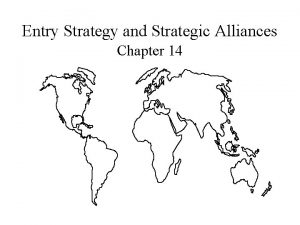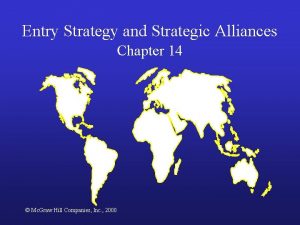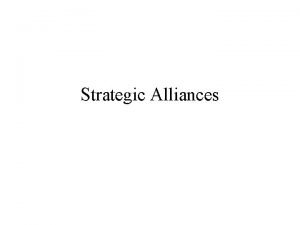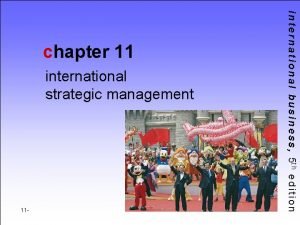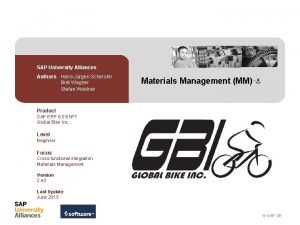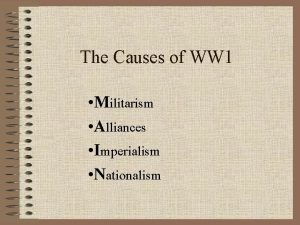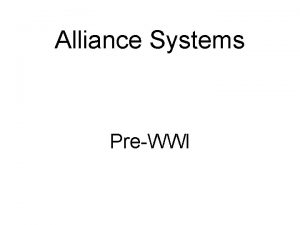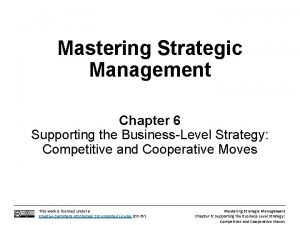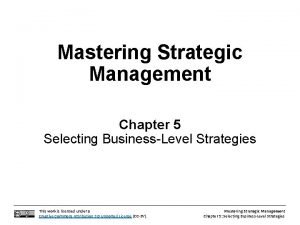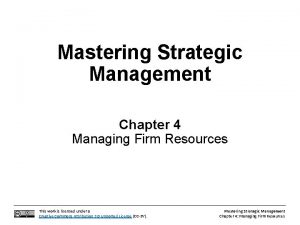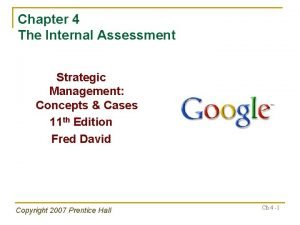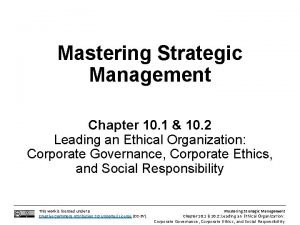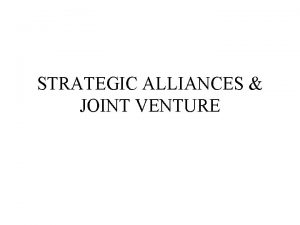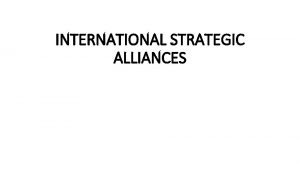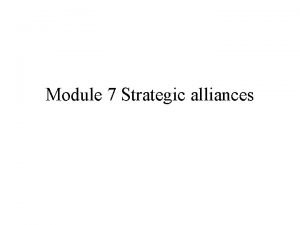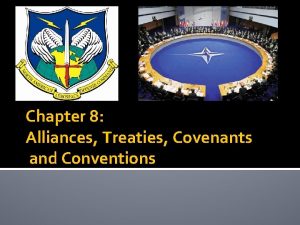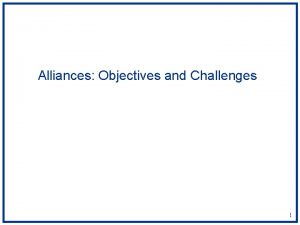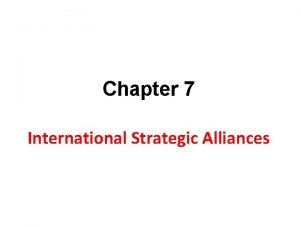Chapter 9 International Strategic Alliances Design and Management













































- Slides: 45

Chapter 9 International Strategic Alliances: Design and Management Copyright© 2007 Thomson Learning All rights

Learning Objectives • Know the steps for implementation of successful international strategic alliances • Understand how to link value chains in international strategic alliances • Understand the importance of choosing the right partners for alliances • Know the important characteristics to look for in potential alliance partners Copyright© 2007 South-Western/Thomson Learning All rights

Learning Objectives • Know the differences between equity-based international joint ventures and other types of international cooperative alliances • Know the basic components of an international strategic alliance contract • Understand the control systems and management structures used in alliance organization Copyright© 2007 South-Western/Thomson Learning All rights

Learning Objectives • Appreciate the unique problems in human resource management • Realize the importance of interfirm commitment and trust • Understand how companies assess the performance of their international strategic alliances • Know when companies should continue or dissolve their international strategic alliances Copyright© 2007 South-Western/Thomson Learning All rights

Strategic Alliances Issues • Increasingly popular strategy to develop new product and to expand into new markets • However, strategic alliances are very risky and unstable • Failure rate of 30% to 60% • Even profitable alliances can be torn by conflict Copyright© 2007 South-Western/Thomson Learning All rights

Exhibit 9. 1: Implementing a Strategic-Alliance Strategy Copyright© 2007 South-Western/Thomson Learning All rights

Where to Link in the Value Chain • Alliance combining same value-chain activities are to gain efficiencies, merge talents, or share risks • Upstream/downstream alliances serve the objective of low-cost supply/manufacturing • Operations/marketing alliances provide access to markets • Depends on the objective that the firm seeks to achieve Copyright© 2007 South-Western/Thomson Learning All rights

Exhibit 9. 2: Linking Value Chains in Strategic Alliances: Some Examples Copyright© 2007 South-Western/Thomson Learning All rights

Exhibit 9. 3: Value-Chain Links in US International Alliances Copyright© 2007 South-Western/Thomson Learning All rights

Choosing a Partner: The Most Important Choice? • Key criteria for picking an appropriate alliance partner - Seek strategic complementarity • Understand objectives and seek complementarity - Pick a partner with complementary skills • One that enhances but does not necessarily duplicate an alliance partner’s skills Copyright© 2007 South-Western/Thomson Learning All rights

Criteria for Choosing Partners - Seek out companies with compatible management styles - Seek a partner that will provide the “right” level of mutual dependency - Avoid the “anchor” partner • Anchor partner: a partner that holds back the strategic alliance because it cannot or will not provide its share of the funding Copyright© 2007 South-Western/Thomson Learning All rights

Criteria for Choosing Partners (cont. ) - Be cautious of the “elephant-and-ant” complex • Occurs when two companies are greatly unequal in size - Assess operating-policy differences with potential partners - Assess the difficulty of cross-cultural communication with a likely partner Copyright© 2007 South-Western/Thomson Learning All rights

Exhibit 9. 4: International Strategic Alliances for Small Multinational Companies Copyright© 2007 South-Western/Thomson Learning All rights

Choosing an Alliance Type • Three main types of strategic alliances - Informal international cooperative alliances - Formal international cooperative alliances - International joint venture Copyright© 2007 South-Western/Thomson Learning All rights

Informal International Cooperative Alliance • Non-legally binding agreements between companies from two or more countries - Agreements of any kind - Provide links anywhere on their value chains - Limited involvement between companies Copyright© 2007 South-Western/Thomson Learning All rights

Formal Cooperative Alliances • Higher degree of involvement than informal alliances • Formal contract • Popular in high tech industries because of high costs and risks Copyright© 2007 South-Western/Thomson Learning All rights

International Joint Ventures (IJV) • Separate legal entity owned by two or more parent companies from different countries • No need for equal ownership • Equity based on cash or other contributions • Ex. : One partner brings technology while other partner brings financial contributions Copyright© 2007 South-Western/Thomson Learning All rights

Exhibit 9. 5: Types of Alliances Copyright© 2007 South-Western/Thomson Learning All rights

Negotiating the Agreement • IJV negotiation issues - equity contributions - management structure - “prenuptial” agreements Copyright© 2007 South-Western/Thomson Learning All rights

Exhibit 9. 6: Selected Questions for a Strategic. Alliance Agreement Copyright© 2007 South-Western/Thomson Learning All rights

Organizational Design in Strategic Alliances • Depends on the type of alliance chosen • Informal ICAs often have no formal design issues • Formal ICAs may require separate organization unit housed in one company • IJV—Parent companies set up separate legal entity Copyright© 2007 South-Western/Thomson Learning All rights

Decision-making Control • Majority ownership does not necessarily control - Operational decisions - Strategic decisions • In IJVs, strategic decision making takes place at the level of IJV’s board of directors or top management. Copyright© 2007 South-Western/Thomson Learning All rights

Management Structures • Dominant parent: controls or dominates strategic decision making - Often has majority ownership - Treats the IJV as wholly owned subsidiary • Shared management: both parent companies contribute approximately the same number of managers to the alliance organization Copyright© 2007 South-Western/Thomson Learning All rights

Management Structures • Split control management control: partners usually share strategic decision making and split functional decision making • Independent management structure: alliance managers act more like managers from a separate company - IJVs often recruit managers from outside the parent companies Copyright© 2007 South-Western/Thomson Learning All rights

Management Structures • Rotating management: key positions rotate among partners - Popular in developing countries - Trains management talent and transfers expertise Copyright© 2007 South-Western/Thomson Learning All rights

Choosing a Strategic Alliance Management Structure • If partners have similar technologies or knowhow and contribute equally - Shared management structure preferred • If partners have different technologies but contribute equally - Split management structure preferred • If one partner has dominant equity position - Dominant management structure more likely Copyright© 2007 South-Western/Thomson Learning All rights

Choosing a Strategic Alliance Management Structure • For joint ventures • Mature joint ventures move to independent structures as the joint venture’s management team gains more expertise • Joint ventures in countries with a high degree of government intervention produce IJVs with local partner dominance • Independent management structures are more likely when the market is expanding, the venture does not require much capital, or the venture dose not require much. Copyright© R&D 2007 input from its Learning All rights South-Western/Thomson

Human Resource Management in Strategic Alliances • HRM functions include recruiting and staffing for alliance positions • The HRM functions of an IJV are more complex - Managers (and sometimes workers) come from two or more firms or from two or more cultures Copyright© 2007 South-Western/Thomson Learning All rights

Critical HRM Problems and Issues • HRM planning: Employees need to know strategic intent of alliance. • Parent involvement: As alliances get older and larger, they tend to develop their own HRM practices. • Staffing the alliance management and technical personnel—crucial and risky decision Copyright© 2007 South-Western/Thomson Learning All rights

Critical HRM Problems and Issues • Staffing the alliance workforce • Assigning managers strategic or operations tasks • Performance assessment—needed for retention, promotion and salary decisions • Loyalty—managers may often feel dual loyalty - To parent and to alliance Copyright© 2007 South-Western/Thomson Learning All rights

Critical HRM Problems and Issues • Career development—must provide clear information on how alliance assignments fit within careers • Cultural differences • Training Copyright© 2007 South-Western/Thomson Learning All rights

Exhibit 9. 7: HRM Issues in Strategic Alliances Copyright© 2007 South-Western/Thomson Learning All rights

Commitment and Trust • Commitment: putting forth extra effort to make the venture work - Attitudinal commitment: willingness to dedicate resources and efforts and face risks to make the alliance work • If partners demonstrate these aspects of commitment, alliance will develop based on fair exchange. - Occurs when partners believe that they receive benefits from the relationship equal to their contributions Copyright© 2007 South-Western/Thomson Learning All rights

Calculative Commitment • Commitment also has a practical side: calculative commitment • Alliance partner evaluations, expectations, and concerns regarding potential rewards from the relationship • Businesses require tangible outcomes for a relationship to continue Copyright© 2007 South-Western/Thomson Learning All rights

Trust • Commitment and trust go hand in hand • Credibility trust: confidence that the partner has the intent and ability to meet promised obligations and commitments • Benevolent trust: confidence that the partner will behave with goodwill and with fair exchange Copyright© 2007 South-Western/Thomson Learning All rights

Exhibit 9. 8: The Trust/Commitment Cycle Copyright© 2007 South-Western/Thomson Learning All rights

Why Is Trust Important? • When there is no trust, partners hold back or take advantage of each other. • Formal contracts can never identify all issues that will arise • Technology and knowledge also include tacit elements that can only be learned through trust. Copyright© 2007 South-Western/Thomson Learning All rights

Building and Sustaining Trust and Commitment • • Pick your partner carefully Know each side’s strategic goals Seek win-win situations Go slowly Invest in cross-cultural training Invest in direct communication Find the right levels of trust and commitment Copyright© 2007 South-Western/Thomson Learning All rights

Exhibit 9. 9: The “Right” Levels of Trust and Commitment Copyright© 2007 South-Western/Thomson Learning All rights

Assessing the Performance of an International Strategic Alliance • If strategic intent is to produce immediate results, standard financial and efficiency measures can be used. • Other strategic alliance provide indirect strategic benefits. • IJV and ICA performance criteria: often must include criteria other than financial, such as organizational learning. Copyright© 2007 South-Western/Thomson Learning All rights

Exhibit 9. 10: Selected Performance Criteria for Strategic Alliance Copyright© 2007 South-Western/Thomson Learning All rights

If the Alliance Does Not Work • Negotiate an end or improve implementation • Know when to quit/invest more • Avoid “escalation of commitment” - Companies continue in an alliance longer than necessary because of financial and emotional investments. • Plan end—“prenuptial agreements” • Death not always failure Copyright© 2007 South-Western/Thomson Learning All rights

Dedicated Strategic Alliance Unit • Provide processes and procedures that help managers identify the need for an alliance • Evaluate partners • Negotiate agreements • Structure the alliance organizations • Develop specific performance indicators Copyright© 2007 South-Western/Thomson Learning All rights

Key Lessons from Cross. Border Alliances • Understand appreciate business and cultural differences • Keep strong executive support • Communicate • Negotiate logic before control • Commitment, trust and dedication • Have “checkpoint” as the alliance is being implemented • Review alliance’s viability Copyright© 2007 South-Western/Thomson Learning All rights

Conclusion • Use of international strategic alliances continues to grow in international business • Chapter provides solid understanding of the basics and how to manage strategic alliances • Strategic alliances are prone to failure and great effort must be taken to make them successful Copyright© 2007 South-Western/Thomson Learning All rights
 Entry strategy and strategic alliances
Entry strategy and strategic alliances In terms of the build borrow or buy framework
In terms of the build borrow or buy framework Entry strategy and strategic alliances
Entry strategy and strategic alliances Entry strategy and strategic alliances
Entry strategy and strategic alliances Disadvantages of strategic alliances
Disadvantages of strategic alliances Resource based model
Resource based model Analysing the 6 strategic options megxit
Analysing the 6 strategic options megxit Global issues in strategic management
Global issues in strategic management Alliances and acquisitions
Alliances and acquisitions Global issues
Global issues Strategic compulsions in international business management
Strategic compulsions in international business management International strategic management process
International strategic management process Imperialism definition ww1
Imperialism definition ww1 Ww2 alliances
Ww2 alliances Types of functional alliances
Types of functional alliances Doctrines et alliances
Doctrines et alliances World war 1 teams
World war 1 teams Mao
Mao Angeliki dedopoulou
Angeliki dedopoulou Sap university alliances
Sap university alliances World war one alliances cartoon
World war one alliances cartoon Militarism alliances imperialism nationalism
Militarism alliances imperialism nationalism Alliance of three emperors 1881
Alliance of three emperors 1881 Complements and substitutes
Complements and substitutes Strategic fit vs strategic intent
Strategic fit vs strategic intent Process of strategic cost management
Process of strategic cost management Mastering strategic management
Mastering strategic management Strategic management chapter 5
Strategic management chapter 5 Strategic management chapter 4
Strategic management chapter 4 Chapter 1 the nature of strategic management
Chapter 1 the nature of strategic management Strategic management
Strategic management Strategic management chapter 7
Strategic management chapter 7 Implementing strategies management and operations issues
Implementing strategies management and operations issues Implementing strategies: management and operations issues
Implementing strategies: management and operations issues Strategic management chapter 6
Strategic management chapter 6 What is internal assessment in strategic management
What is internal assessment in strategic management Chapter 3 planning organization and management
Chapter 3 planning organization and management Strategic management chapter 7
Strategic management chapter 7 Strategy implementation example
Strategy implementation example External audit in strategic management
External audit in strategic management Strategic management chapter 10
Strategic management chapter 10 Strategic cost management chapter 1
Strategic cost management chapter 1 Chapter 2 strategic management
Chapter 2 strategic management Chapter 2 strategic management
Chapter 2 strategic management Concentric growth strategy
Concentric growth strategy Chapter 6 strategy analysis and choice
Chapter 6 strategy analysis and choice
